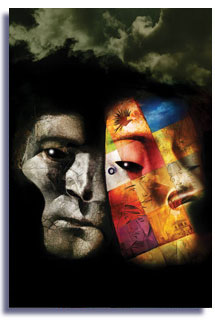| Hey
Kids! Comics!
SANDMAN:
ENDLESS NIGHTS hardcover
Stories: Neil Gaiman
Art: various
The ten-plus
volumes of The Sandman, Neil Gaiman's magnum opus about the
changes and rebirths of seven personified abstract concepts
whose names begin with D, are already heaped so high with
critical superlatives that this entire sentence is redundant.
If I were to add
a few raves to the pile, it's not that they would be false
or without merit, just pleasantly unnecessary. My point is
that this is exactly how I see Endless Nights: true
to the vision, pleasant, of merit, but contributing almost
nothing we didn't already know.
The Dream
story, pre-released in the preview
issue, was wisely chosen as bait, since it's the only
one of the seven that makes any significant references to
Sandman continuity. Of the remainder, we have three anecdotes
(Death, Desire, Destruction), two art showcases (Delirium,
Destiny), and one arty anthology within an anthology (Despair).
All are
worth reading, but it helps to set your expectations correctly:
none answer any questions you might have about Dream's relatives,
none ask new questions for further explorations of their characters,
and frankly the more straightforward stories barely require
their
respective Endless guest star to appear as an actual character.
Death's
story is beautifully illustrated by P. Craig Russell; it's
a subtle allegorical tale that takes a while to sink in. The
Desire story is as erotic as you might hope, thanks to Milo
Manara, and effectively stands alone as a tale of female power
in a male-dominated time. The Destruction story comes with
somewhat pedestrian art by Glenn Fabry, and unfortunately
the writing matches; there are some interesting concepts,
but it never really takes off into unexpected territory.
Though
Delirium's and Despair's sections look superficially different,
they really take a similar approach, presenting sketches of
individuals in various states of madness or despair accompanied
by complex and sophisticated art. Delirium's is structured
as a story (and, happily, includes an appearance by Daniel,
Morpheus's successor as Dream) and
Despair's as fifteen "portraits," but neither aims
beyond illustration to insight.
Both are
feasts for the eyes, but I wish Gaiman had gone a bit further
to really come to grips with these two Endless, particularly
Despair. Her portraits are lucid and eloquent, but still
somehow manage to feel evasive, as if Gaiman wasn't really
sure how to structure a narrative around an emotion this unrelenting.
Destiny
closes the book without ever really opening it. Frank Quitely's
art is incredible, gorgeous white and bronze and sand just
shining on the page, but the writing here is the least satisfying.
Gaiman offers little more than captions for the illustrations,
and those disinclined to believe in fate will find little
here to stimulate their imaginations in that direction.
A lot
of Sandman fans are proud to have a row of lavish graphic
novels on their shelves, and if you are in this category you
will probably have already bought the hardcover. If you are
less devoted and less fetishistic, more interested in the
narrative than the visual and tactile, you might as well wait
for a softcover edition, or better yet borrow this from a
friend first. The writing is undeniably literate, the art
mostly exquisite, but of the original Sandman -- complex,
rich,
wordy, bursting with connections and allusions and foreshadowing,
treating the Endless more as characters than concepts -- this
is only a distant mirror.
Rating:

|






